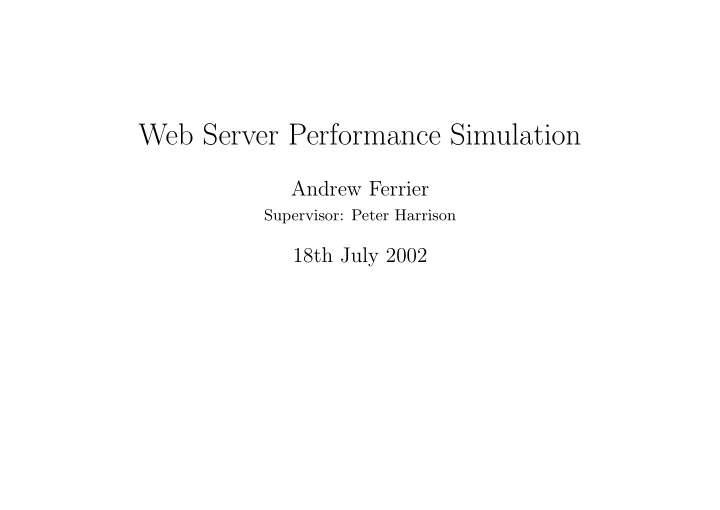

Web Server Performance Simulation Andrew Ferrier Supervisor: Peter Harrison 18th July 2002
Aims / Parts 1. Creation of WS 3 (Web Server Simulation System) — simulates generic systems. 2. Web Serving Guidelines using WS 3 — by evaluating hypothetical models.
Background and Motivation • Increasing use of web: performance issues. • Notorious failures (e.g. UK 1901 Census). • Capacity planning tools tend to be: – Flooding tools. – General simulation tools/toolkits. – GUI tools. – Non-web-specific.
Simulation Simulation uses virtual time-stream; queueing network; statistical distributions to create inter-event times. • Good at answering specific questions. • Quick and easy — unlike queueing theory. • Requires attention to accuracy and general pattern discovery may be difficult.
Design of WS 3 Objectives: • Easy-to-use. • Unlikely to cover everything so designed for future extension. Decisions: • Java (programming language). • XML (input file format — for system specification), XML Schema, Apache Xerces Parser. • Simulation Toolkit (Tony Field) — process based.
SimToolkit SimToolkit_Manager SimToolkit_SimulatedObject Queue 1 1 WS3 0..* Processes Message WS3_SimulatedObject WS3_System Client NetworkNode Server
Implementation Issues Implementation mostly straightforward. However: • Randomness — x n = f ( x n − 1 ). • Equilibrium. • Added features: – Routing System Changed. – Server Multithreading and Multiprocessors. – Tracing / Data Dumping. – Queue Length Capping. – Others (see report).
Queue�Length 10 20 30 40 50 60 70 80 90 0 1 14 27 40 53 66 79 92 105 118 131 144 157 170 183 N[0]QueueLength 196 209 222 Virtual �Time 235 248 261 S[0]QueueLength 274 287 300 313 326 339 352 365 378 391 404 417 430 443 456 469 482 495
Cumulative�Utilisation 0.2 0.4 0.6 0.8 1.2 0 1 1 14 27 40 53 66 79 92 105 118 131 144 157 170 183 196 N[0]Utilisation 209 222 Virtual �Time 235 248 261 S[0]Utilisation 274 287 300 313 326 339 352 365 378 391 404 417 430 443 456 469 482 495
Testing / Evaluation Distinction • Testing — TST — Validity test cases: part of software creation. • Evaluation — CNC — Hypothetical queueing systems: used to discover guidelines: second part of project. Also discussed accuracy, speed of simulation, etc. (in report)
Testing Test cases for: • Invalid XML / Invalid XML for WS 3 . • Simple test cases — checked with queueing theory • Boundary condition cases (large names, unusual parameters etc.) • Others (see report)
Evaluation Second (and smaller) part of project. One unusual and interesting example from report. Purpose was to P rocessors examine ratio: on a single server. T hreads C1[0] C1[1] C1[2] N1 S1
Evaluation Procedure • 50 clients. Varied P rocessors ratio. Ran simulations T hreads (equilibrium-adjusted). • Plotted server utilisation, client response time, other parameters. Most interesting pattern discovered was. . .
25 Mean�Client�Response�Time�(Virtual�s) 20 15 10 5 0 0 0.2 0.4 0.6 0.8 1 1.2 Processors �/�Threads
Conclusion 1. Created WS 3 — many features: clients, network nodes, multi-processor and multi-threaded servers, 8 different statistical distributions, different queue lengths, network node message dropping etc. . . 2. Evaluated WS 3 — hypothetical system evaluation, discussed speed, accuracy etc.
Future Extensions • Features for WS 3 : an empirical distribution, time-based demand variation, different types of requests, etc. . . • Graphical interface for industrial use. • More analysis of: different hypothetical models, accuracy.
Any Questions? andrew@new-destiny.co.uk http://www.new-destiny.co.uk/andrew/project/ DoC: ajf98 Thanks to: Peter Harrison, Uli Harder, and Tony Field
C[2] C[3] C[4] C[0] C[1] N[0] S[0]
Cumulative�Utilisation 0.2 0.4 0.6 0.8 1.2 0 1 1 14 27 40 53 66 79 92 105 118 131 144 157 170 183 196 N[0]Utilisation 209 222 Virtual �Time 235 248 261 S[0]Utilisation 274 287 300 313 326 339 352 365 378 391 404 417 430 443 456 469 482 495
Queue�Length 10 20 30 40 50 60 70 80 90 0 1 14 27 40 53 66 79 92 105 118 131 144 157 170 183 N[0]QueueLength 196 209 222 Virtual �Time 235 248 261 S[0]QueueLength 274 287 300 313 326 339 352 365 378 391 404 417 430 443 456 469 482 495
Recommend
More recommend